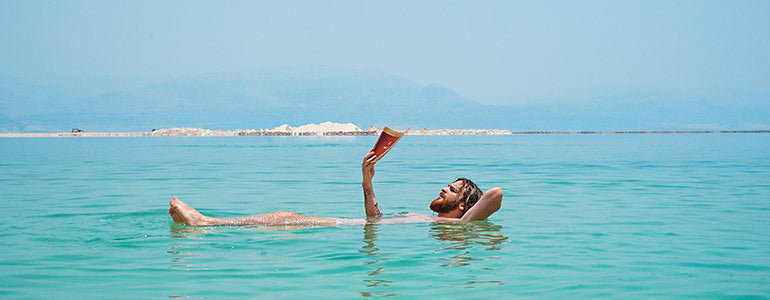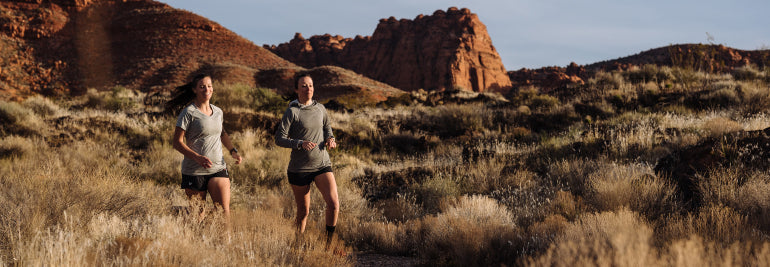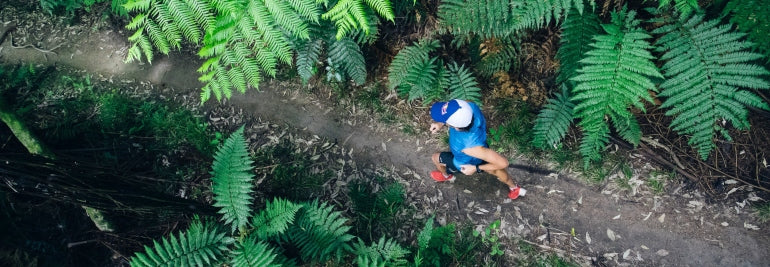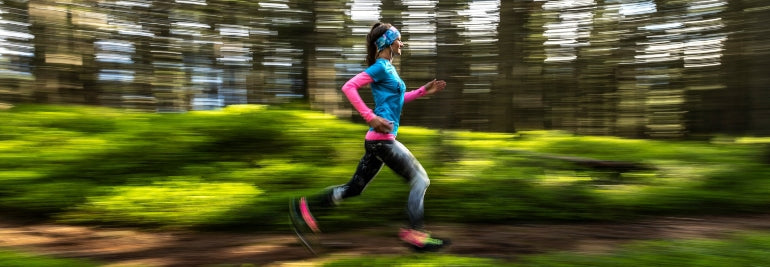

SUUNTOブログ

Running books to read on your summer vacation
Summer holidays are a time to rest and recharge, and also an opportunity to reignite our inspiration. Whether you’re having a "staycation", on a multi-day hiking trip in the mountains, sunbathing at the beach or on a family road trip, take along one of these six books about running and you will get yourself motivated for your training in the second half of the year.
1. Above the Clouds: How I carved my own path to the top of the world.
Two-time National Geographic Adventurer of the Year and Suunto ambassador Kilian Jorney has broken mountaineering records all over the world. Kilian Jornet's new book, Above the Clouds, recounts his life of studying and ascending the greatest peaks on earth. Kilian reveals his process and on what he has found in nature—simplicity, freedom, and spiritual joy.
2. Sky Runner: Finding Strength, Happiness, And Balance In Your Running, by Emelie Forsberg
Suunto ambassador and four-time back-to-back Skyrunner World Series champion Emelie Forsberg lives for the outdoors. It’s part of everything the Swedish running phenomena does. In this book, she shares her passion for mountain running and expert insights into this demanding sport. Buy it here.
3. Trail Blazer: My Life as an Ultra-distance Runner, by Ryan Sandes
Ryan Sandes has run ultras in some incredible places: Antarctica, the Sahara and the Gobi deserts, and recently set a fastest known time record on the Great Himalayan Trail. In his usual easy-going and down-to-earth style, he tells his incredible story. Buy it here.
4. Training Essentials for Ultrarunning: How to Train Smarter, Race Faster, and Maximize Your Ultramarathon Performance, Jason Koop
If you’re looking for a challenge in the second half of your year, how about running an ultra marathon? If you’re called to the challenge, then this training book by ultra running coach to elite athletes Jason “Coach” Koop is a must have. Reading it will set up your training programme. But it here.
5. The Way of the Runner: A Journey into the Fabled World of Japanese Running, by Adharanand Finn
You might be as surprised as we were to discover that Japan is the most running obsessed nation on Earth. Author, journalist and runner, Adharanand Finn has followed up on his first book – Running with the Kenyans: Discovering the Secrets of the Fastest People on Earth – with another book that delves into Japan’s one-of-a-kind running culture and what it might teach us about the sport and about Japan. Buy it here.
6. Run or Die, by Kilian Jornet
When it comes to running, Kilian Jornet is a different kind of beast; ski mountaineering, vertical races, ultra marathons, mountaineering, fastest known time records – he is king of all. In 2017, he made two lightning speed ascents of Everest in a single week, completing his Summits of my Life project. This is a classic written by a super athlete. Buy it here.
Lead image: © Photo by Toa Heftiba on Unsplash
Know your resting and max heart rate
Keeping track of your heart rate is vital for endurance athletes. In this article Suunto partner PerfectPace explains the ins and outs.
Knowing your max heart rate is an important guide for athletes. It gives you a roof for your training and indicates the level of intensity. On the other hand, one of the first signs of overtraining syndrome is an elevated resting heart rate. For endurance athletes doing high volume training this is essential to watch out for.
Identifying your maximum and resting heart rate is vital for the calculation of training zones. Particularly for endurance training these numbers are very important and they are not hard to come to. But there are a few things to consider.
Source: Age-predicted maximal heart rate in healthy subjects: The HUNT Fitness Study
How to find your maximum heart rate
You have probably heard of the formula 220 minus age to get your maximum heart rate. Some say that this formula is not too exact but all in all the results are ok. Unfortunately that is not the case. In most cases the result is way off.
A Norwegian study on more than 3300 healthy women and men has tested their maximum heart rate. The graphic below shows the result. What we can see is that the average values for the whole population is on a straight line. But for most individuals their maximum heart rate is far from that line. The conclusion is that the formula works for the average global population but not for an individual.
When looking at the graph it is also evident that no formula can calculate the individual maximum heart rate. The results are just too scattered. The only way to get to your max HR is via a test.
How to test your maximum heart rate
The maximum heart rate should be tested in your sport. Runners should run and swimmers swim. Triathletes should do a run test. The heart rate is the highest in running of all three sports.A max HR test is VERY demanding. You need to go to your limit and that will hurt.
A typical test for runners looks like this:
Warm up for at least 10 minutes. Now increase your tempo for 5 minutes until you get out of breath. This is the time to start a one minute spurt. It will hurt but you need to max out. Depending on your ability to push yourself you’ll get close to your maximum heart rate.
How to find your resting heart rate
Like for the maximum heart rate there is no formula to calculate your resting heart rate. The resting heart rate is even more individual than the maximum heart rate. Some sport watches can measure your pulse while sleeping. In the morning you will have your resting heart rate.
If you don’t have such a device you can simply measure your heart rate right after you woke up. Untrained have a resting heart rate between 60-80 bpm. Endurance athletes might have only 35 bpm. The reason for such differences are adaptations to the cardiovascular system. The heart gets stronger and more efficient when under high load but also when resting.
Changes of the maximum and resting heart rate
The heart rate changes during your lifetime. Simply by getting older. A new born baby has a resting heart rate of 130-140 and it drops with every year. This is the reason why the formula 220 minus age came up. But there are a lot more factors than just age that influence your heart rate all the time. Therefore you should test again from time to time to make sure your training zones match your physiology.
But there are also short term changes in your heart rate. You won’t be able to reach your max heart rate every day. Also the resting HR is changing from day to day up to 15 beats per minute. reasons can be a cold or over training. By checking your resting heart rate regularly you can spot abnormal stress levels early and adapt your training.
PerfectPace is the endurance training platform for triathletes that takes you a step ahead. For a steady performance gain you had to know a lot about training methodology to plan your training sessions. Especially in a sport like triathlon where three sports need to be planned correctly. This is where PerfectPace steps in. It offers not only unique statistics that up to now were only available in expensive desktop applications but it also helps to create a plan that boosts your performance with the help of artificial intelligence, big data and the latest advances in training science. PerfectPace considers not only your training activities but also rest days, tapering, even injury and your personal strengths and weaknesses.
Lead images:
Photo by Brian Erickson on Unsplash
© Kevin Scott Batchelor
Read more articles
10 reasons to enjoy open water swimming with Suunto
The benefits of training to music and making your best playlist

Suunto 7で計測する歩数とカロリーについて知っておくべきこと
Suuntoウォッチは、あなたの毎日の活動を追跡したり、スポーツや回復度をモニタリングするのに正しい選択です。 Suuntoウォッチはあなたのアシスタント、トレーナー機能だけではなく、バディ機能も兼ね備えた高機能時計です。
最新のソフトウェアアップデートにより新型のSuunto Today Tileに対応するSuunto 7は、あなたのすべての歩数をカウントし、運動量をカロリー消費量で推定表示するとともに、次のトレーニングまでに必要な回復時間を表示する準備ができています。
これらの指標は、あなたが自分の体の状態をよく理解できるように、Suunto Wear Appを用いてあなたのトレーニングを記録するとき、または単にお使いのSuuntoウォッチを装着するだけで生成されます。
このチュートリアルでは、それらの指標を以下のように分析しています。
歩数
意味
あなたは「1日1万歩の健康法」という言葉を聞いたことはありますか?
これはあなたの毎日の歩数合計を示します。歩数合計の一部はあなたが行うトレーニングに含まれています。 この数字自体は、あなたの健康とフィットネスを実現するための徒歩や運動によって得られる効果に比べるとそれほど重要ではありません。
方法
お使いのSuuntoデバイスの内部アルゴリズムは、あなたの体の動きを追跡し、それらの動きを加速度計(あなたの手首加速度を歩数に変換するセンサーの一種)を用いて歩数に変換します。
あなたの体の移動方向と歩む方向との間で行われる変換を考えると、注目に値するのは、歩数カウントがGPSデータに依存しないことと、毎日の結果の精度は異なる場合があることです。 あなたのトレーニング時に、一部のスポーツモードでは歩数があなたの毎日のカウントに追加されますが、他のスポーツモードでは追加されません。 歩数をあなたの毎日のカウントに追加しない、完全なスポーツのリストを以下に示します。
エアロビクス、バドミントン、ボウリング、ボクシング、チアリーディング、サーキットトレーニング、インドアクライミング、登山、クロスフィット、クロストレーナー、ベーシックサイクリング、通勤サイクリング、サイクリング-インドアトレーナー、ダンス、体操、インドアサイクリング、インドアトレーニング、ケトルベル、カイトサーフィン、武道、モータースポーツ、マウンテンバイクでのサイクリング(エンデューロ)、マウンテンバイクでのトレイルサイクリング、パラグライディング、ラケットボール、ローラースキー、セーリング、スカッシュ、ストレッチング、サーフィン、卓球、テニス、不特定のスポーツ、バレーボール、ウェイトトレーニング、ウィンドサーフィン、ヨガ/ピラティス、カヌーイング、クロスカントリースキー、インドアローイング、カヤッキング、プールスイミング、オープンウォータースイミング、ローイング、スタンドアップパドリング、テレマークスキー
すべてのステップカウンター(簡単に言えば歩数計)が様々なアルゴリズムを使用して、体の動きを解釈して歩数を計算することを記載することは重要です。 GoogleエコシステムとSuunto App間、さらにはあなたのスマートフォンの健康アプリとの間でもわずかな変動が見られる可能性があります。 それらの変動はSuuntoデバイス精度に悪影響を与えるものではなく、単に様々な計算例とセンサー校正例を示すものです。
保存場所
毎日の歩数は、お使いのSuuntoウォッチのSuunto Today Tile上およびSuunto App内のあなたのダイアリーに保存されます。そこでは日毎、週毎、月毎、または年毎の統計をチェックすることができます。 Suunto App設定では、あなたの歩数目標を設定して、あなたの限界を押し上げるパーソナライズされた方法を創出することもできます。
カロリー
意味
あなたの体内に密かに潜んで、毎日あなたを少しづつ太らせている小さな生き物?残念ながら、誰もが知っているこうした小さな生き物と対処する必要があります。
カロリーは、人間の体が最適に機能するために必要な最も重要なエネルギー単位の1つです。 あなたには、生きるために最低限必要な量のカロリーだけでなく、健康な代謝率を維持し、筋肉と臓器をつくるのに役立つ十分なカロリーを消費する必要もあります。 よって、あなたのカロリー消費量をモニタリングすることはお使いのSuuntoウォッチの重要な仕事です。
方法
Suuntoのウォッチは、あなたがトレーニング中に消費した総エネルギーをカロリー単位で示すことができます。 その計算は2つの重要な数字を利用して行われることに注意してください。その1つはBMR(基礎代謝率)としても知られる「生きるために最低限必要なカロリー量」であり、もう1つは、より関心が高い「アクティブカロリー」として知られている追加の「スポーツ燃焼カロリー量」です。
言うまでもなく、BMRの計算はお使いのSuuntoウォッチ使用開始時に入力を求められる個人データに基づいて行われるので、必要に応じてその個人情報を編集することをお勧めします。
さらに、あなたの毎日の歩数は、その日に消費したアクティブカロリー数も増加させます。
保存場所
毎日の燃焼カロリー数(BMR+アクティブカロリー)は、お使いのSuuntoウォッチのSuunto Today Tile上およびSuunto App内のあなたのダイアリーに表示されます。そこでは日毎、週毎、月毎、または年毎の統計を確認できます また、Suunto App設定では、あなたのカロリー目標を設定することもできます。あなたがカロリー目標を設定すると、あなたのBMRに加えて、燃焼するカロリー数を決定します。言い換えれば、あなたのカロリー目標は「アクティブカロリー」に相当します。 体にストレスをかけすぎないように注意してください。
回復
意味
「時間をつぶす」、「時間を節約する」、「時間を作る」というフレーズはすべて重要ですが、「回復時間」ほど重要ではありません。回復時間中はあなたのSuuntoウォッチがあなたのトレーナーになり、「時間を取る」というもう一つのの重要なフレーズを教えてくれます。
回復時間とは、あなたが以前に記録した任意のトレーニングからあなたの体が完全に回復するのに要した時間に基づく推定時間です。 あなたのトレーニングが困難で体力を消耗させるものであればあるほど、筋肉へのストレスが大きくなり、あなたの体が完全に回復するのに時間がかかります。休息しリラックスする時間を取ることによって、あなたはトレーニングの次のレベルに到達することができます。
あなたの運動を記録するのにSuunto Wear Appを使用しない場合は、この推定時間は得られません。 この推定時間は、最低1時間以上の回復時間を要するトレーニングの記録を終了した時点で表示されます。
方法
お使いのSuuntoウォッチ機能により、あなたのトレーニング全体を通して収集されたデータ、つまりあなたの一般情報を利用するデータに基づいて回復時間が計算されます。あなたの一般情報が最新であることを忘れずに確認してください。
あなたの次のトレーニングセッションを計画する際に考慮すべきもう1つの重要なことは、回復時間は累積的な性質を持つため、継続的に変化するということです。
あなたのトレーニング時間が長く、あなたの筋肉に負担をかければかけるほど、回復時間は長くなります。また、回復カウントダウンタイマーがゼロになる前にトレーニングを行うと、新しい回復時間が既存の回復時間に追加されます。 ストレスばかりが大きく、楽しくないトレーニングは筋肉損傷を誘発する可能性があるだけでなく、あなたの運動能力を低下させる可能性もあります。 残りの回復時間がゼロになるのを待つのは運動の一部ではないと誰が言いましたか?
保存場所
回復時間は、お使いのSuuntoウォッチのSuunto Today Tile上およびSuunto App内のあなたの運動サマリーに表示されます。 あなたの回復時間は、Suunto Wear App(右上ボタン)を用いてあなたのトレーニングを記録した場合にのみ、お使いのSuuntoウォッチに表示されます。

4 tips to recover well for your best performance
The Suunto Summer Challenge on Map My Run this July is all about inspiring you to create a workout routine and sticking to it. One oft ignored component to keep your training steady is ensuring you are getting enough recovery time. It can seem like taking a break from running will disrupt your momentum, but oftentimes it does the exact opposite – it freshens you up and reinvigorates you.
Proper recovery time allows the body to adapt in response to your workouts. It also prevents overtraining syndrome – which can knock out of the game for months if you get it. Our running coach Denise Sauriol – the Marathon Whisperer – is a huge advocate of recovery. She sees it as an essential component in any training block. Below are her four tips to do it well.
To participate in the Suunto Summer Challenge all you need to do is sync your Suunto App with Map My Run, get out training, reach new badge levels and be in to win one of four Suunto 7 GPS smartwatches! Full details here.
© Graeme Murray/Red Bull Content Pool
Take the plunge
Swimming is an incredible workout for the whole body. The weight of your body is carried by the water, allowing muscles to relax. It’s a great form of active recovery. Especially the day after your long run. It helps minimize delayed onset muscle soreness.
Try open water swimming if public pools are closed. And if you really want to energize your system, give cold water swimming a go.
Recovery means downtime
Recovery days are meant to be off days not travelling all over town taking care of errands. Make sure you really get the downtime you need. Consider making your recovery days technology-free, and instead go for a swim, a gentle stroll in the park, or read a book on the couch.
The Suunto 7 smartwatch ‘recovery time’ feature tracks your workouts and gives you an estimation on how long you need to recover from your exercise based on stats like duration and intensity. Recovery is a key element of both your training and overall wellness. Remember, it helps prepare you for adventures to come.
Don’t fight yourself
If you have too many days in a row where it’s a mental and physical fight to get through a workout, I recommend you take two to three days off. By doing this you are giving yourself a “control-alt-delete” reset for your mind and your body. You will see on your next run you will come back stronger because of the extra, unplanned day off.
Check your resting heart rate
A way to test if you are overtraining is to check your resting heart rate when you first wake up. If it is abnormally high, this could be a sign that you should reduce the intensity of your plan over the next few weeks until your heart rate is back to normal.
Tracking your daily heart rate is easy with the Suunto 7 smartwatch.
This is the third and final article in the Suunto Summer Challenge on Map My Run happening throughout July. The challenge is all about creating a workout routine and sticking with it!
Lead images:
© Graeme Murray/Red Bull Content Pool
Read more articles
Welcome to the Suunto Summer Challenge
12 must-read running articles to boost performance
Running books to read on your summer vacation

4 tips to keep your training fresh and effective
To continue to improve your running performance and keep it interesting, varying your training is essential. If you do the same thing day in day out, it’s easy for it to become mechanical, resulting in a loss of motivation. Time to mix it up!
In this second article for our Suunto Summer Challenge on Map My Run, happening this July, our coach Denise Sauriol – The Marathon Whisperer – lays out four tips to keep your runs fun and inspiring!
To participate in the Suunto Summer Challenge all you need to do is sync your Suunto App with Map My Run, get out training, reach new badge levels and be in to win one of four Suunto 7 GPS smartwatches! Full details here.
© Graeme Murray/Red Bull Content Pool
Turn up the intensity
If you want to race at a pace faster than you train, you will have to incorporate higher intensity runs into your training. These speed workouts and tempo runs are what I call “gritervals” because you have to call on some internal grit to get through them. They are performed at a much faster pace than your easy runs.
Even when I coach beginner runners, I slowly incorporate speed workouts into their training plan. One reason is that my runners will see their pace improve sooner and the second reason is the sense of accomplishment they get from doing these types of workouts.
If you're new to speed drills, start very gradually. Here's how: to warm up walk briskly for five minutes, then jog at an easy pace for five minutes, then increase your pace to 50% of your maximum capacity for a minute or two, then shift to running more quickly, like around 80% of your max capacity, for 30 seconds (but don't sprint). Repeat this two or three more times and then warm down.
Cross train
It’s important to incorporate cross training into your training routine as it not only mixes things up, so you are less likely to get bored, but it also helps make you a stronger more balanced athlete.
By cross training, you will be working more muscles than just those running strengthens. Since our most valuable commodity is our time, why not choose two of the most effective cross training exercises, swimming and rowing? They both target all your muscle groups in one shot!
Build mental toughness
Adding high intensity workouts doesn’t just help us physically, but I believe they also indirectly improve our mental endurance. Again, this is because we must dig deeper to get through them compared to our easy runs. We are making the manageably-uncomfortable, comfortable!
This is important because our mental endurance is what we call on in the latter part of our races when the legs may want to quit, but the mind will push on bravely. One great way to build mental toughness is to incorporate hill training repetitions.
Run mindfully
Out on your runs, practice being guided by your senses. Once in a while leave your watch and phone at home. Run and really listen to your foot strike, feel your breathing, the wind and elements on your face and body.
Try this presence exercise: touch your index finger to your thumb on each hand in time with your in and out breath. Consciously, look around at what you are experiencing rather than only worrying about time, pace or your heart rate zone.
This is the second article in the Suunto Summer Challenge on Map My Run this July. The challenge is all about creating a workout routine and sticking with it!
Lead images:
© Graeme Murray/Red Bull Content Pool
© Damien Rosso / Red Bull Content Pool

5 tips to be a consistent runner
The feeling of freedom, of almost floating across the earth, is one of the main reasons we run. Those sometimes elusive runner’s highs make all the hard training worthwhile.
Getting to that point, when running feels effortless and liberating, takes consistency. Without it, we stay at a level that involves more perseverance than inspiration. Becoming consistent takes our running to another level.
In this first article in the Suunto Summer Challenge on Map My Run, happening throughout July, we explore what it takes to become a consistent runner. Read on for sage advice from the Marathon Whisperer, and get out training to reach new badge levels to be in to win one of four Suunto 7 GPS smartwatches.
To participate in the Suunto Summer Challenge all you need to do is sync your Suunto App with Map My Run, and start logging workouts. Full details here.
© Graeme Murray/Red Bull Content Pool
Ask the Marathon Whisperer!
Runner and coach Denise Sauriol – nicknamed the“Marathon Whisperer” – is here to help you find your running consistency. No one can question her dedication – she has run 117 marathons! Denise is a certified running coach and the author of the book, Me, You & 26.2, a guide to running your first marathon.
Whether you are just getting started with running or coming back after taking some time off, here are five tips to ignite your training and keep the fire burning!
Plan your training
Training plans provide focus, but it’s hard to design one without having a race or a goal on the horizon. Running without having a goal to shoot for is like studying without having to take a final exam. You are going to be more likely to run if you know you have a race or goal down the road. Your plan will give you short term objectives (daily runs and recovery days) and a long term goal to focus on.
Extra tip: Make sure your plan isn’t too easy or too hard, but just right.
Make running a priority
Running or any exercise for that matter is an investment in yourself. Make your runs official appointments in your calendar. Treat it just like you would a doctor’s appointment. If you don’t schedule it and make it official, you are more likely to let other to-dos take up your run time. To minimize the chance of missing your run, lace up and head out the door first thing in the morning. Even better is to head out for your run before looking at your phone in the morning.
Make a public commitment
Once you sign up for a race or set yourself a goal, tell your friends and family about it. Without them even knowing it, they will be accountability buddies for you as they are likely to ask you about your training throughout the season and ask you about race day. Knowing these questions could come next time you see them will keep you on your toes.
Find a running partner
This not only helps the miles go by, but also helps to keep you more accountable. If you are new to running and or new to your area, check out your local running store as most of them have group fun runs where you are bound to find someone with a similar pace. If you can’t find anyone to run with, bring an e-partner with you to help the miles go by, for example, music, podcasts or audibles.
With the Suunto 7 GPS smartwatch you can connect your headphones to your phone and control music and other audio – adjust volume, pause and skip tracks – straight from your wrist without taking your phone out of your pocket. You can also listen without your phone – the Suunto 7 can store thousands of tracks so you can play your favorite songs or other audio on the go.
Before your next run, load up the three playlists on our Spotify channel prepared by the Mambo Brothers: chilled, upbeat and intense!
Be packed and ready
Whether you are running first thing in the morning, during your lunch break, or after work, pack your running gear the night before so it’s one less thing to worry about when you are ready, set and raring to go!
This article is the first in the Suunto Summer Challenge on Map My Run this July. The challenge is all about creating a workout routine and sticking with it!
Lead images:
© Joerg Mitter for Wings for Life World Run
Photo by Andrew Heald on Unsplash










































































